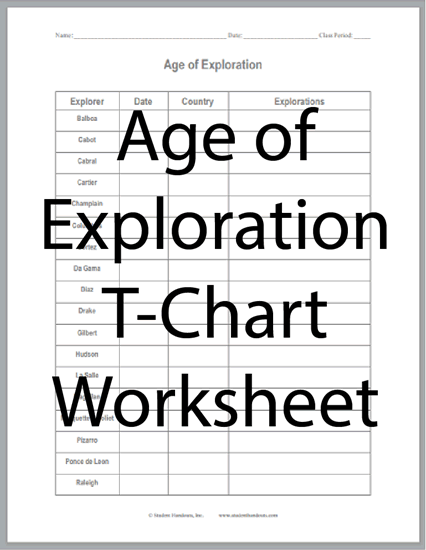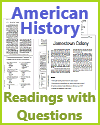| Age of Exploration T-Chart Worksheet |
|---|
| www.studenthandouts.com ↣ World History ↣ Age of Exploration ↣ Age of Exploration Worksheets |
| Students are asked to complete this chart, describing the explorations of the following: Balboa, Cabot, Cabral, Cartier, Champlain, Columbus, Cortez, De Gama, Diaz, Drake, Gilbert, Hudson, La Salle, Magellan, Marquette and Joliet, Pizarro, Ponce de Leon, and Raleigh. |
 |
    |
 |
|
Click here to print (PDF). Answers will vary.
Vasco Núñez de Balboa: Balboa, a Spanish explorer, is known for crossing the Isthmus of Panama in 1513 and becoming the first European to reach the Pacific Ocean. He claimed the Pacific and all its shores for Spain. John Cabot (Giovanni Caboto): An Italian explorer sailing under the English flag, Cabot is credited with discovering parts of North America, likely the coast of Newfoundland, around 1497. Pedro Álvares Cabral: This Portuguese explorer is noted for his 1500 expedition to Brazil. While en route to India, he accidentally discovered the eastern coast of South America, making him one of the first Europeans to set foot in Brazil. Jacques Cartier: A French explorer, Cartier is best known for his explorations of Canada, including the Gulf of St. Lawrence and the St. Lawrence River, in the early 16th century. Samuel de Champlain: A French explorer, Champlain is often called the "Father of New France." He founded Quebec City in 1608 and made numerous journeys exploring the Great Lakes and northeastern North America. Christopher Columbus (Cristoforo Colombo): The Italian explorer sailing for Spain is renowned for his four voyages to the Americas (1492, 1493, 1498, and 1502). His voyages marked the beginning of European exploration in the New World. Hernán Cortés: Cortés, a Spanish conquistador, is famous for his conquest of the Aztec Empire in Mexico (1519-1521), leading to the establishment of New Spain. Vasco da Gama: A Portuguese explorer, da Gama is known for his successful voyage around the Cape of Good Hope to reach India in 1498, establishing a sea route to the East. Bartolomeu Días: Another Portuguese explorer, Dias is the first European known to have sailed around the southern tip of Africa, known as the Cape of Good Hope, in 1488. Francis Drake: An English privateer and explorer, Drake circumnavigated the globe (1577-1580) and was involved in the English defeat of the Spanish Armada in 1588. Sir Humphrey Gilbert: An English explorer, Gilbert attempted to establish a settlement in Newfoundland in 1583 but died at sea on the return journey. Henry Hudson: An English explorer sailing for the Dutch, Hudson explored parts of North America, including the Hudson River, in the early 17th century. René-Robert Cavelier, Sieur de La Salle: A French explorer, La Salle is known for his extensive explorations of the Mississippi River and the Gulf of Mexico in the late 17th century. He claimed the entire Mississippi River Valley for France. Ferdinand Magellan: A Portuguese explorer sailing for Spain, Magellan led the first expedition to circumnavigate the Earth (1519-1522), though he was killed in the Philippines. Jacques Marquette and Louis Joliet: Marquette, a French Jesuit missionary, and Joliet, a French-Canadian explorer, are credited with exploring the Mississippi River in 1673. They sought a water route to the Pacific. Francisco Pizarro: A Spanish conquistador, Pizarro is famous for his conquest of the Inca Empire in Peru (1532-1533), leading to the establishment of New Castile. Juan Ponce de León: A Spanish explorer, Ponce de León is known for discovering Florida in 1513 and is associated with the legend of the Fountain of Youth. Sir Walter Raleigh: An English explorer and soldier, Raleigh sponsored the failed Roanoke Island colony in the late 16th century. These explorers made significant contributions to the Age of Exploration, expanding geographical knowledge and influencing the course of history in the Americas, Africa, and Asia. |
| www.studenthandouts.com ↣ World History ↣ Age of Exploration ↣ Age of Exploration Worksheets |








